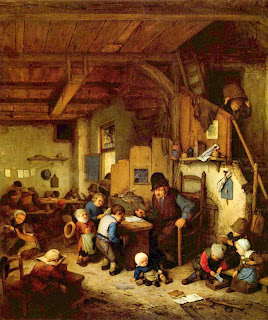Christopher Columbus (or rather Cristobal Colon) is often celebrated as a hero and has been assigned his own personal day alongside truly remarkable people like Martin Luther King Jr. Columbus defied many obstacles and managed to sail halfway around the world. His bravery and determination led to one of the most significant discoveries in world history. Christopher Columbus brought us sugarcane and the land of great dreams and promises that the American continent has ensured for centuries since.
Upon reading Howard Zinn, I saw a completely different facet to this account of history. Previously, I was aware that Columbus' main motive and driving force were stacks of gold and that his discovery was sheer luck based on serious miscalculation. At the same time, he was also religious to the bone, and he was planning to bring his own message of salvation to any primitive people he might run into along the way, whom he collectively and erroneously referred to as “Indians.”
In fact, his arrogance, greed and ethnocentrism knew no bounds. When meeting native Indians, his head was filled with material gain. The Arawaks welcomed him and shared all their possessions with the newcomers, not having been exposed and contaminated by the unnatural love for money and gold. But to Columbus they seemed naive, even insane. Who in their right mind would share their possessions so freely, especially with a stranger?
So instead of enjoying and thanking them for their unbridled hospitality, he forced them to show him where the gold was hid. It did not help the cause of the Arawaks that they did not have any weapons except spears made of cane, which were definitely no match to the swords and armor of the Spaniards. In fact, Columbus noted with amusement that when he produced a sword, the natives were so clumsy and so ignorant that they accidentally cut themselves with its blade.
To add to his profits Columbus decided to take various Indians captive so he could sell them as slaves back in his home country for an extra bit of income. That various of them died on the trip especially due to the harsh conditions and the cold climate must have been a blow to his income and pride, but it hardly touched his personal integrity.
Moreover, his sailors who remained behind at the fort called “Navidad” fell short of the Christmas spirit and gifts; they took absolute control over the island, forcing the natives into labor, raping their girls and women while killing those who resisted these abject and inhumane living conditions. In fact, various Arawaks saw no other way out and committed mass suicide through poisoning.
Some of the cruelty as observed by Bartolomé de Las Casas was that Indians were knifed by the sailors to test the sharpness of their blade, and a particularly horrifying incident in which sailors took away the parrots of two native boys beheading the kids just for fun while keeping the parrots.
One of the unspoken and often overlooked legacies of the “Admiral of the Seas” was the decimation of large parts of the native population. Instead of peace and salvation, he mostly brought the natives violence, hatred, death and destruction. These inhabitants were driven off, regarded as subhumans and were exploited ruth- and heartlessly. Religious values, such as empathy, compassion, justice were all wiped out by the incentive for power, control and wealth.
Despite all, Columbus is still revered and is given his day in the United States. The bloodshed is buried and forgotten, perhaps even forgiven, just like a bitter aftertaste from the past that is dissolved by the sweet success of subsequent generations of settlers, all of which has led to the impressive world status and industry of this young budding nation and its annual celebration of Columbus Day.






